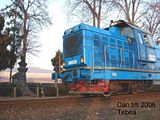cautind ceva pe net am gasit o referire la linia ingusta Timisoara -Orsova.
Ori eu nu cunosc istoria, ori e o greseala?
Staff of the Directorate consisted of seven Austro-Hungarian officers and military officials, 30 civilian officials from Austria and Hungary and a number of other staff ââŹâ all foreign. Local workers served as auxiliary staff. The military administration ordered that the section to Derventa must be completed in two months. Railway engines and available cars, owned by ââŹĹHigel and SagelââŹĹ company which was to build tracks in Bosnia, were transferred from Romania, where narrow-gauge track Timişoara-OrĂ ÂĄava was being completed. These circumstances determined the future character of B&H railroads with narrow-gauge tracks of 0.76 m. Track to Derventa was built by 40 engineers and 4.000 workers, with several very difficult points along the route. There was no time for preparation of any technical studies and project analyses.
Citatul este din istoricul caii ferate din Bosnia si Hertegovina, compania Federatiei Croato-Musulmane.
http://www.zfbh.ba/
siteul companiei Republicii Srpka e mai putin detaliat.
Intre timp am dat o raita pe la sirbi, care de asemenea mentioneaza ceva din Romania.
The year 1854 was important for Yugoslav Railways history. Namely, on the 20th of August, 1854, the LisavaââŹâOravicaââŹâBazijas line was opened to horse-drawn traffic and in November, 1856, to traffic with steam traction. After World War I, there remained 27 km long stretch of this line on our territory, from the national border near Jam, via Jasenovo and Bela Crkva, to the national border between Vracev Gaj and Bazijas. Gradually some parts of the line were being dismantled, thus only the stretch of line between Jasenovo and Bela Crkva is in operation today. All subsequently constructed main lines in Vojvodina were laid towards Pesta.
http://www.zeleznicesrbije.com/active/en/home/glavna_navigacija/o_preduzecu/istorijat_zeleznice.html
Ori eu nu cunosc istoria, ori e o greseala?
Staff of the Directorate consisted of seven Austro-Hungarian officers and military officials, 30 civilian officials from Austria and Hungary and a number of other staff ââŹâ all foreign. Local workers served as auxiliary staff. The military administration ordered that the section to Derventa must be completed in two months. Railway engines and available cars, owned by ââŹĹHigel and SagelââŹĹ company which was to build tracks in Bosnia, were transferred from Romania, where narrow-gauge track Timişoara-OrĂ ÂĄava was being completed. These circumstances determined the future character of B&H railroads with narrow-gauge tracks of 0.76 m. Track to Derventa was built by 40 engineers and 4.000 workers, with several very difficult points along the route. There was no time for preparation of any technical studies and project analyses.
Citatul este din istoricul caii ferate din Bosnia si Hertegovina, compania Federatiei Croato-Musulmane.
http://www.zfbh.ba/
siteul companiei Republicii Srpka e mai putin detaliat.
Intre timp am dat o raita pe la sirbi, care de asemenea mentioneaza ceva din Romania.
The year 1854 was important for Yugoslav Railways history. Namely, on the 20th of August, 1854, the LisavaââŹâOravicaââŹâBazijas line was opened to horse-drawn traffic and in November, 1856, to traffic with steam traction. After World War I, there remained 27 km long stretch of this line on our territory, from the national border near Jam, via Jasenovo and Bela Crkva, to the national border between Vracev Gaj and Bazijas. Gradually some parts of the line were being dismantled, thus only the stretch of line between Jasenovo and Bela Crkva is in operation today. All subsequently constructed main lines in Vojvodina were laid towards Pesta.
http://www.zeleznicesrbije.com/active/en/home/glavna_navigacija/o_preduzecu/istorijat_zeleznice.html

